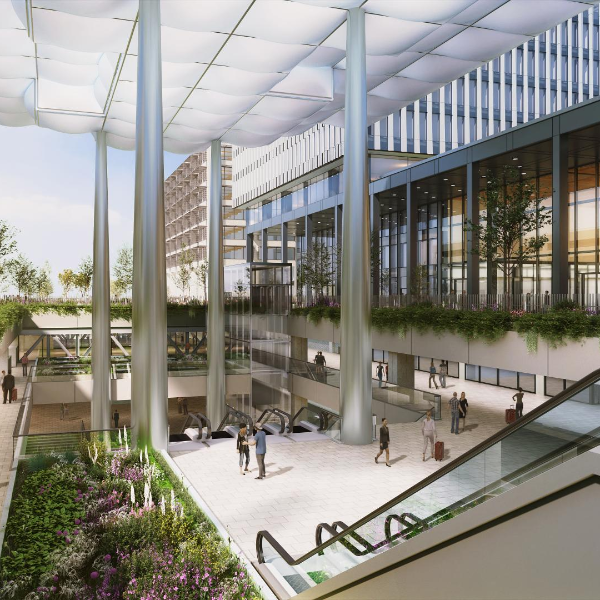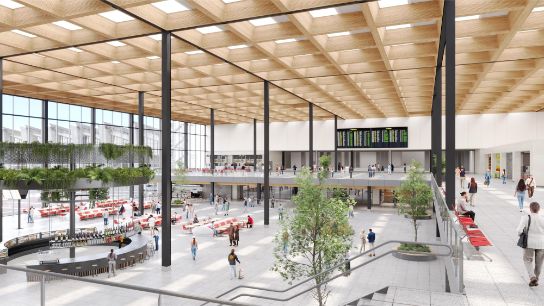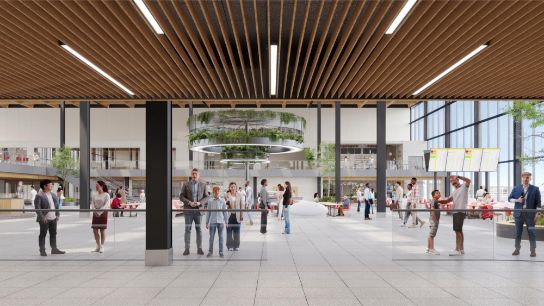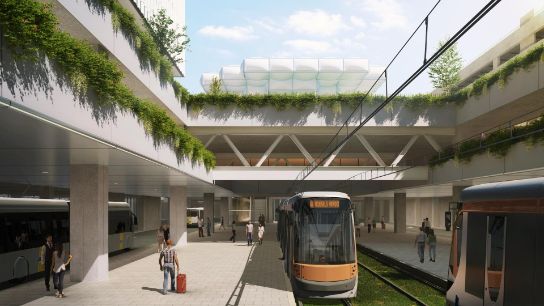Brussels Airport
Belgian-Dutch team focuses on ‘Passenger Experience’ in ambitious Brussels Airport infrastructure project

Brussels Airport
In the coming years, Brussels Airport will invest heavily in its airport infrastructure. With a new intermodal hub, an expanded departures and arrivals hall, a new hotel, and a green boulevard with an urban park, Brussels Airport Company (BAC) aims to create the capacity needed to accommodate future passenger growth, promote a modal shift, and deliver an outstanding passenger experience.
Through a European procurement procedure that attracted over 40 leading international teams, the Belgian-Dutch consortium of Witteveen+Bos, Benthem Crouwel Architects, OKRA, and Stramien CV was selected to deliver a future-proof design for this ambitious project. In close collaboration with the client, the team will be responsible for architectural design, engineering, and landscape architecture.
The team is supported by several subcontractors. Planeground contributed to the logical functional layout of the buildings and conducted passenger flow analyses. M-gineers is involved in the design and implementation of ATES systems, as well as HVAC, electrical, sprinkler, and security installations. Zonneveld engineers bv supports the design and engineering of key structural components, and 4Building assists in cost estimation and management.
Multifunctional, comfortable, and safe passenger experience
At the heart of the design lies the passenger experience. The terminal expansion will cater to both arriving and departing travellers with a vibrant, welcoming environment that intuitively guides passengers through a wide range of functions.
Currently, 65,000 to 85,000 travellers pass through the terminal each day, pushing its capacity to the limit. The new development will relieve pressure on the existing infrastructure and enhance efficiency, comfort, hospitality, and safety—for travellers, visitors, and airport staff alike.
'The concentration and layering of functions, combined with working in a high-traffic existing environment, make this an incredibly challenging project. It pushes us to fully leverage the breadth of our engineering expertise. So many talented people are working on this with heart and soul—truly one of a kind.'
— Maarten Veerman, Design & Engineering Manager, Witteveen+Bos

A connecting public space creates an urban experience
Brussels Airport currently consists of a spatially fragmented system of functions across various levels. The new design brings together the flow of arriving and departing passengers into one coherent building: the intermodal hub with a central vertical connector. This connector is a recognisable element in an attractive, publicly accessible outdoor space that links to all surrounding buildings.
From this outdoor area, passengers can see the different levels of the intermodal hub through generous openings that provide ample natural light throughout. A large atrium even channels daylight down to the underground train station.
'The design for the new intermodal hub, terminal expansion and hotel is rational, clear, and intuitive. It offers a great user experience while ensuring a highly efficient and modular building setup.'
— Daniel Jongtien, Architect/Partner, Benthem Crouwel Architects

Intermodal hub designed for intuitive wayfinding
At the core of the development is the intermodal hub—a vibrant vertical stack of all transport modes. This central connector links the airport to the train station, a redesigned central bus terminal, a large bike parking facility, an upgraded taxi zone, and eventually the future airport tram terminus. Through this, Brussels Airport actively encourages a modal shift by facilitating and promoting sustainable travel to and from the airport.
Besides enhancing connectivity, the intermodal hub streamlines passenger flow. The central access point intuitively guides travellers to their destinations, safely and efficiently—without the need to cross any roads.
Departures hall with a spectacular view of the tarmac
The departures and arrivals hall will be expanded and redesigned to support future passenger flows and elevate the travel experience.
Departing passengers will be welcomed in a spacious, well-organised hall featuring a fully glazed façade that offers panoramic views of the runway. Natural daylight also enters through the roof. From the air, incoming passengers will see solar panels and an extensive green roof installed on top of the terminal.
'It’s vital that the arrivals area shares in this experience. After border control, passengers enter a bright, high-ceilinged space. The arrivals and departures halls are physically and visually connected by a large atrium.'
- Tine Durnez, Architect/Partner, Stramien CV

New hotel suspended above the terminal
Adjacent to the terminal, a new four-star hotel with over 300 rooms will be built. Together with the existing Sheraton hotel, it will offer more overnight accommodation and serve as a welcoming place to meet, dine, work, or relax.
Green outdoor spaces for passengers and nature
Nature brings calm and comfort. Both inside and outside, the design prioritises greenery. The green boulevard and park form the entrance to the intermodal hub.
The outdoor space will be extensively landscaped, using primarily native species. This greenery will support a sustainable, biodiverse environment while helping to buffer rainwater and mitigate the urban heat island effect. Indoors, green features contribute to a pleasant atmosphere in the newly built spaces.
'The outdoor space connects the various components of the master plan. From the start of the boulevard to the new departures hall, greenery plays a vital role in improving the quality of the public realm. Travelling from Brussels becomes an even more enjoyable experience.'
— Bas Heessels, Landscape Designer/Associate, OKRA

Commitment to sustainability
The new buildings aim to achieve the highest sustainability ratings: BREEAM (Outstanding), WELL (Platinum), and DGNB (Gold)—fully aligned with Brussels Airport’s sustainability strategy. The design team emphasises flexible and modular buildings, timber structures where feasible, sustainable material choices, and circular principles. Energy demand will be kept low, with resilient technologies such as rainwater infiltration, ATES systems, heat pumps, and solar panels integrated throughout.
Timeline
Construction of the intermodal hub, terminal expansion, and hotel is scheduled to begin no earlier than the second half of 2026. The works will be delivered in phases, with the full development expected to be completed by 2032 at the latest.
With this forward-looking investment, Brussels Airport is positioning itself as a leading European hub-strengthening national connectivity while connecting people, businesses, and communities more than ever before.
Pictures © Brussels Airport Company
More information?



